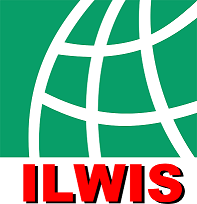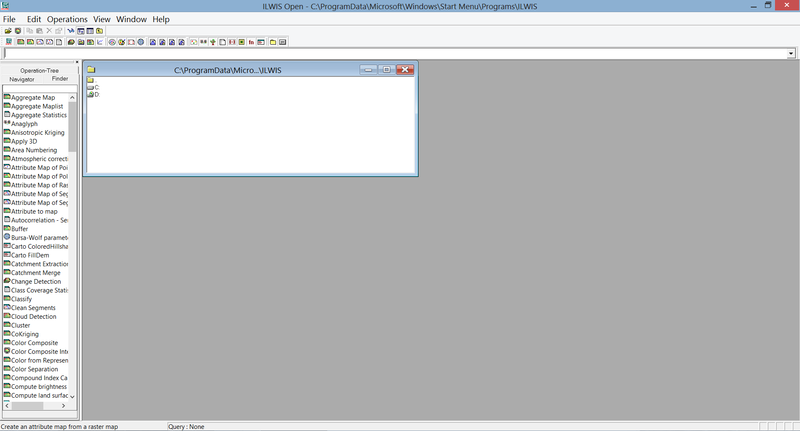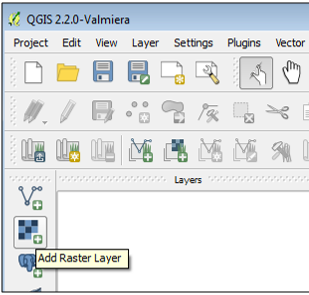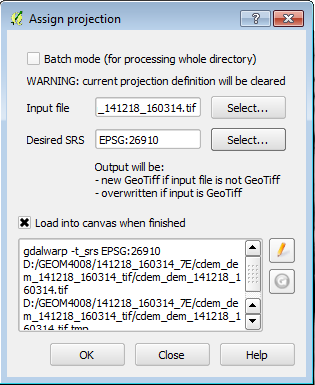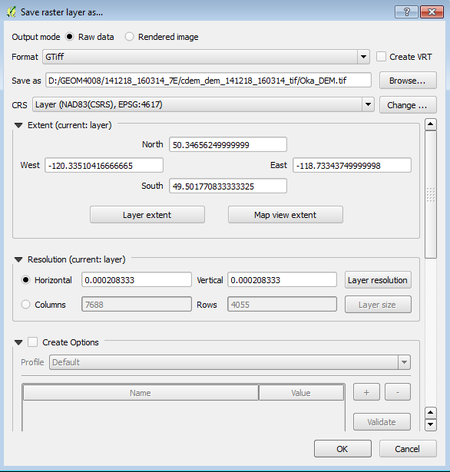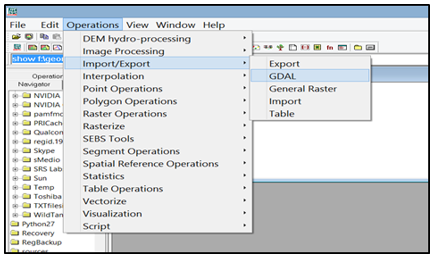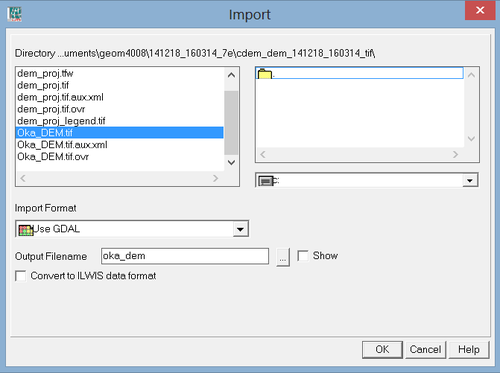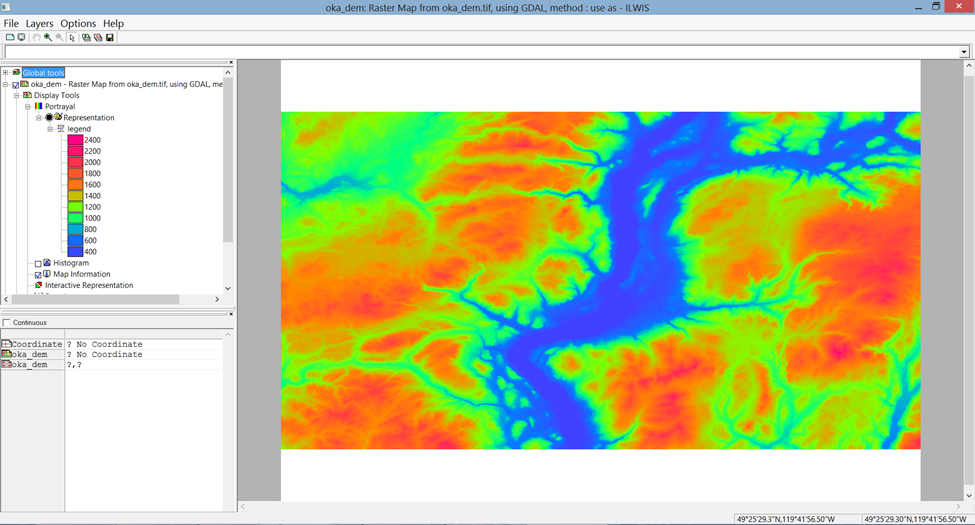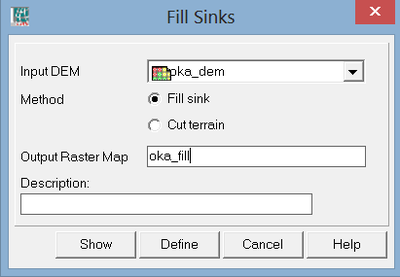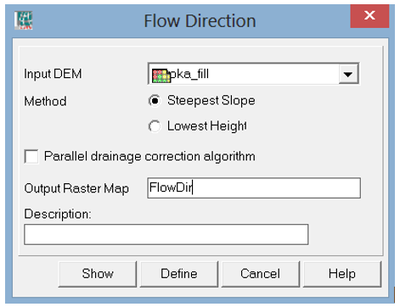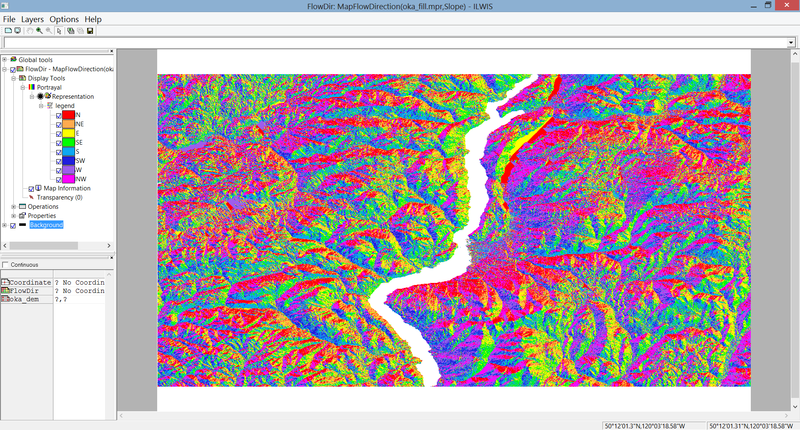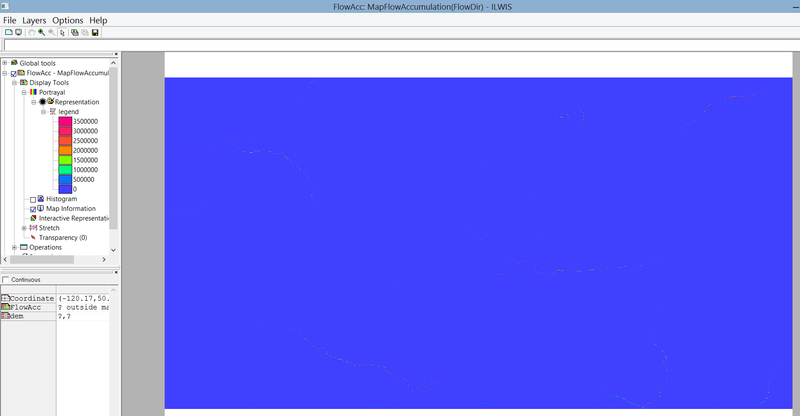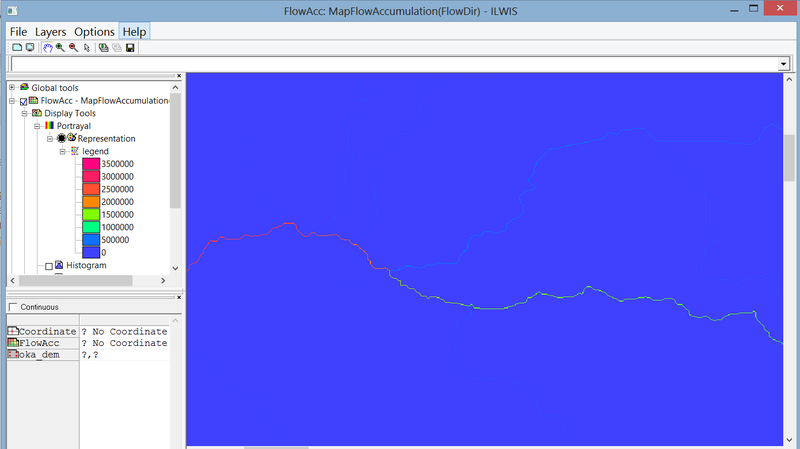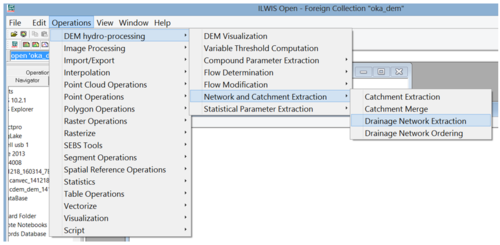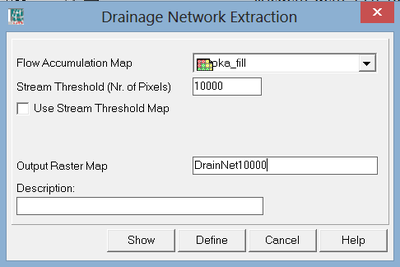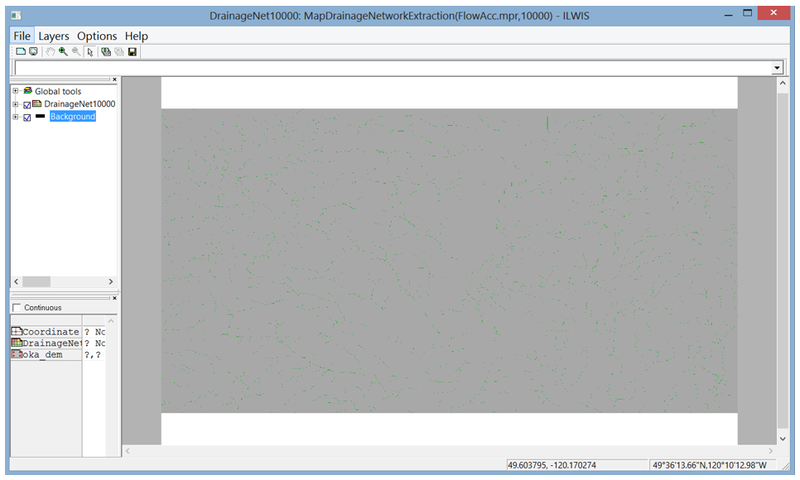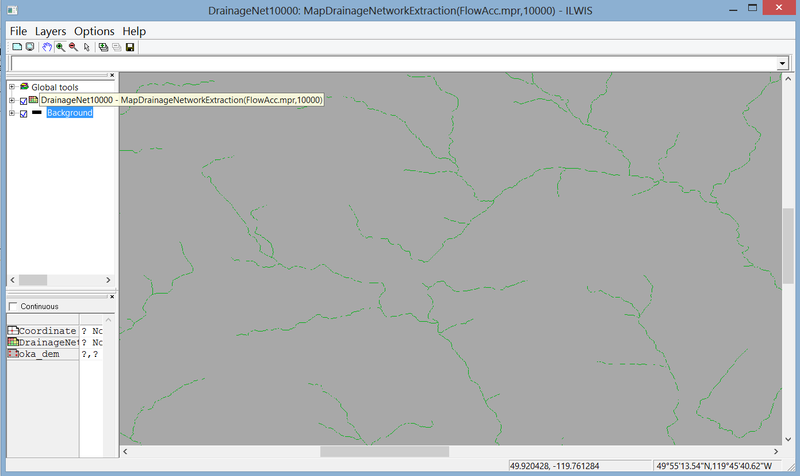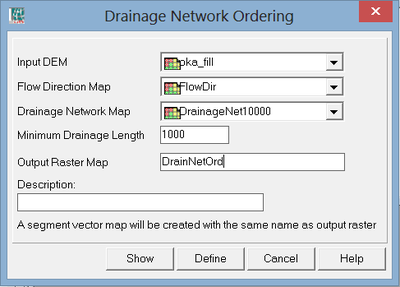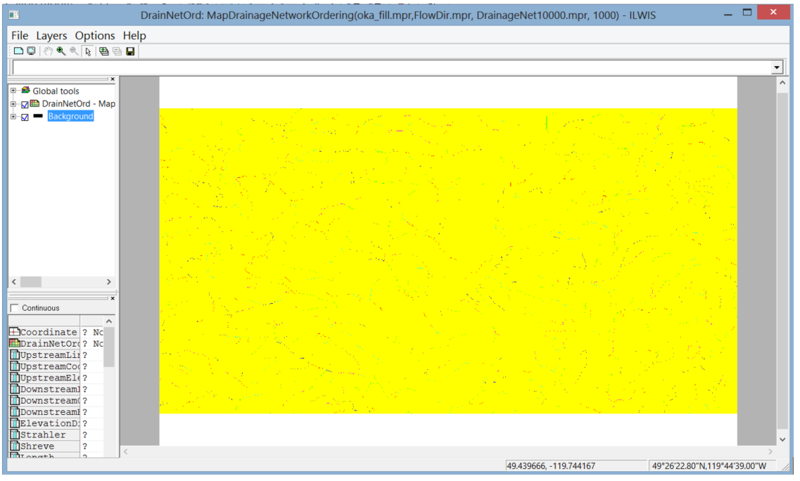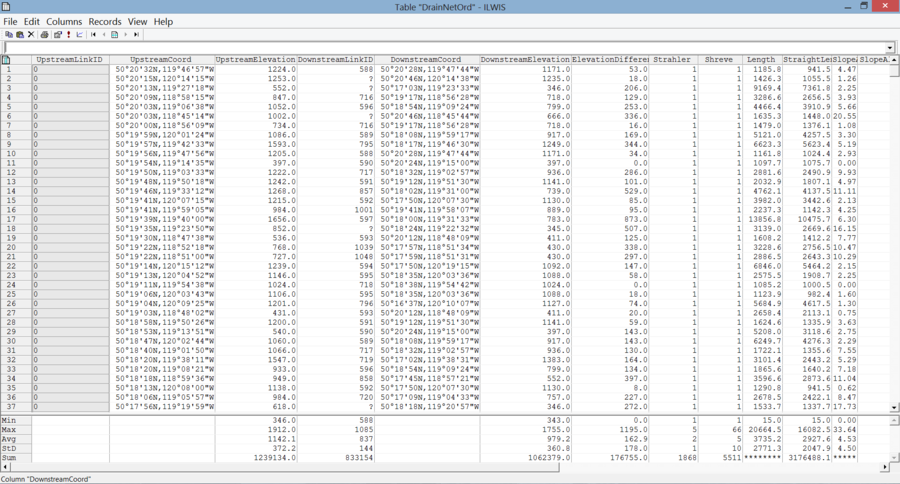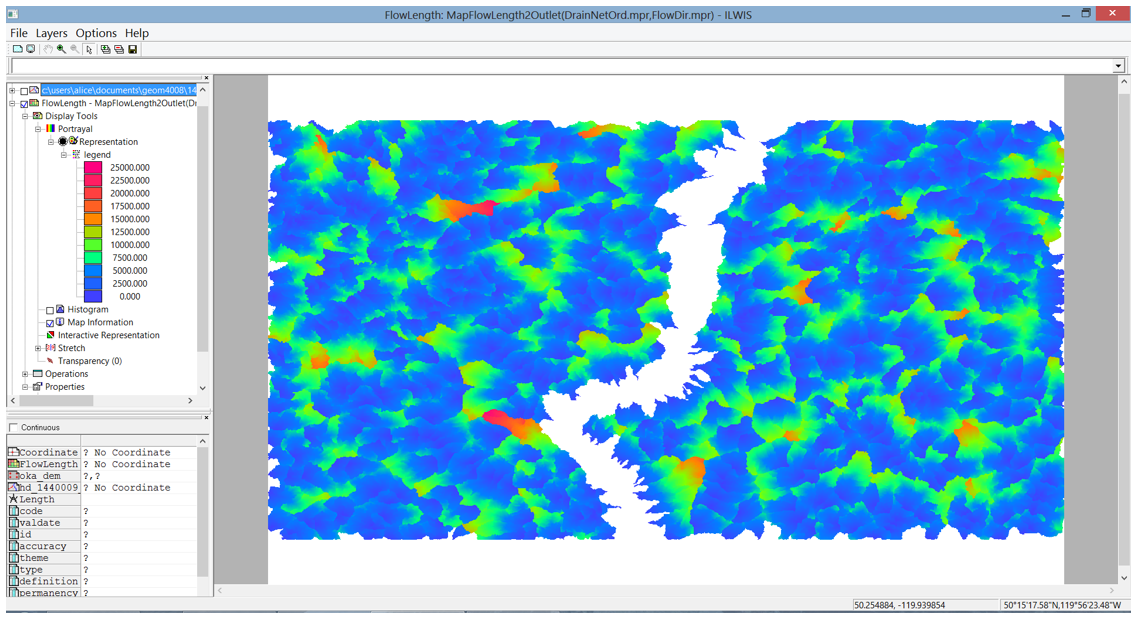Difference between revisions of "Exploring Hydrological Analyses using ILWIS"
| Line 182: | Line 182: | ||
[[File:ILWIS Flow Accumulation path.png]] |
[[File:ILWIS Flow Accumulation path.png]] |
||
| − | ''Figure |
+ | ''Figure 15 - Path to find Flow Accumulation function'' |
[[File:ILWIS Flow Accumulation winodw.png]] |
[[File:ILWIS Flow Accumulation winodw.png]] |
||
| − | ''Figure |
+ | ''Figure 16 - Flow Accumulation window'' |
2) Input '''Flow Direction Map''' and name the output Flow Accumulation map |
2) Input '''Flow Direction Map''' and name the output Flow Accumulation map |
||
| Line 199: | Line 199: | ||
[[File:Zoomed in flow ILWIS flow accumulation.png |800px]] |
[[File:Zoomed in flow ILWIS flow accumulation.png |800px]] |
||
| − | ''Figure |
+ | ''Figure 17 - Zoomed in view of a flow in the Lake Okanagan Flow Accumulation map'' |
===Drainage Network=== |
===Drainage Network=== |
||
Revision as of 20:07, 20 December 2014
Contents
- 1 Purpose
- 2 Introduction to ILWIS and the Project Tutorial
- 3 Methods
- 4 Conclusion
- 5 References
Purpose
This Wiki tutorial has been produced for the purpose of exploring and describing the methods used for hydrological analyses in ILWIS (a FOSS4G program). The objective of this tutorial is to provide users with a better understanding of how the hydrological analyses within ILWIS works, in addition to providing the instructions necessary to reach the desired output for their study region. Additionally, this tutorial will allow for comparison of ILWIS and SAGA GIS, using the same data for analysis as the Exploring Hydrological Analyses using SAGA GIS tutorial from 2013.
Introduction to ILWIS and the Project Tutorial
ILWIS stands for "Integrated Land and Water Information System". It is a open source Geographic Information System software program that was designed to be a user-friendly integrated software that contains both raster and vector processing capabilities, allowing for both analyses on remotely sensed images, vector maps and numerous spatial modeling abilities. ILWIS was developed by the International Institute for Aerospace Survey and Earth Sciences (ITC) in The Netherlands. This tutorial will focus on its ability to use Digital Elevation Models (DEMs)to run hydrological analyses of a study region. More information about this product can be found on the ILWIS Website
This project will focus on hydrological analysis of Okanagan Lake, a popular tourist destination in British Columbia, Canada. The tutorial will cover topics such as Aspect mapping, Slope mapping, Watershed Delineation mapping and Wetness Index mapping through the use of ILWIS hydrological analysis tools.
Methods
Data and Programs
In order to carry out this exercise, a DEM of the area of interest is needed. For this project a open source DEM was obtained using the Geospatial Data Extractiontool created by Natural Resources Canada.
For DEMs located outside of Canada open source DEMs can be obtained from ASTER and SRTM Global Digital Elevation Model - USGS
This turtorial explores the hydrological toolset for ILWIS, but the use of open-source program QGIS is needed as well. This can be downloaded from the QGIS website
Getting Started
Before starting any analysis, create your working folder and ensure all data needed for the exercise are in this folder. Keeping all your data in one folder will make analysis easier.
Starting ILWIS
ILWIS 3.08.03 can be downloaded for free from 52 North.The newer version of ILWIS 3.08.04 is available but do not download this one, as a bug does not allow you to import DEMs into this version.
- Ensure that ILWIS 3.08.03 is properly installed on your computer
- Locate ILWIS from the Program list and double click on the icon to launch program.
- ILWIS main page will open
- Use the ILWIS Navigator Tab to locate your working folder. The Navigator lists all drivers and directories.
Figure 1: Screenshot of ILWIS Interface
Projecting a DEM in QGIS
Projecting in ILWIS did not work, so QGIS (another open source GIS software) was used instead. These steps explain how to load a DEM into QGIS, assign a projection, and export the DEM to be used in other software (e.g. ILWIS)
1) Download QGIS and open the program.
2) Add your DEM using the Add Raster Layer tool (Figure 2). You will have to navigate to the working folder and select the DEM.
Figure 2 - Path to Add Raster Layer command
3) To reproject your DEM click Raster -> Projection -> Assign Projection
4) A new window will open (Figure 3)called Assign Projection, within this window the DEM to projected is selected for input file
Figure 3 - Assign Projection window
5) Click Select.. under desired srs in the Assign Projection window and a new Select Desired SRS window will open (Figure 4).
6) Within this window select the desired coordinate system. Click OK.
(note: For this hydrological analyses, the coordinate system chosen should measure in metres and not in degrees)
Figure 4 - Desired SRS window
7) A new DEM will be added to the QGIS interface with the desired projection
8) The new DEM can be exported by right-clicking it and selecting Save as...
9) A window called Save raster layer as.. will open. Under Save as browse to the desired folder location for your projected DEM and rename it.
Figure 5 - Save Raster Layer As window
10) Click Save. A projected DEM for the region of interest is now saved and can be loaded into ILWIS.
Importing DEMs into ILWIS
Before any analysis can be completed, a DEM of teh region of interest must be imported into ILWIS.
1) Click Operations --> Import/Export --> GDAL (Geospatial Data Abstraction Library)
Figure 6 - Operations to find import tool in ILWIS
2) An Import window will open
Figure 7 - ILWIS import window
3) Click to the DEM you want to import and ensure that the import format is Use GDAL.
5) Give your Output DEM a name and click OK.
* The new DEM (compatible in ILWIS) will save in your working directory
6) To view your DEM right-click on the DEM and select Open
Figure 8 - Projected DEM of Lake Okanagan in ILWIS software
Fill Sinks in a DEM
Fills should be run on DEMs to remove any local depressions, which can cause inaccuracies in following hydrological anlyses.
Within ILWIS there are two Fill Methods:
- Fill Sinks – removes depressions that consist of a single pixel and depressions that consist of multiple pixels. These pixels will then be given the smallest value of adjacent pixels.
- Cut terrain – removes the depressions, does not re-assign values to the pixels but removes them entirely from the DEM
Steps
1) Under Operations select Flow Determination then Fill Sinks
Figure 9 - Path to find Fill Sink operation
2) A Fill Sinks window will open
Figure 10 - Fill Sinks window
3) Input the DEM and decide which Fill method to use (Fill Sinks method was used for the purpose of this tutorial), finally name the output DEM.
4) A new DEM will depression filled will be created and added to the working folder
Figure 11 - DEM with Fill Sink applied
Flow Direction
Flow direction depicts a main direction of flow (run-off). The flow direction operation determines into which neighbouring pixel any water from a given pixel would flow. This is determined by a moving 3x3 window for every single pixel, based on its neighbouring pixels height values
Flow direction can be calculated by two methods:
- Steepest Slope: finds steepest slope of a central pixel to one of its 8 neighbour pixels
- Lowest height: finds the neighbouring pixel with the smallest height value
More information on the methods can be found at thisILWIS Flow Direction webpage
Steps to create a Flow Direction map
1) Operations -> Flow Determination -> Flow Direction
Figure 12 - Path to Flow Direction
Figure 13 - Flow Direction window
2) Input the Fill DEM
3) Choose a flow direction method
4) Click Show
5) The Flow Direction map will save in the working folder and open in a new window
Figure 14 - Flow Direction Map for Lake Okanagan
Flow Accumulation Map
Flow Accumulation performs a cumulative count of the number of pixels that would flow into any given cell on the way to an outlet. This operation is commonly used to determine potential drainage patterns of terrain.
Flow Accumulation is calculated from the map created in Flow Direction, counting the number of cells that would drain into outlets based on the flow direciton.
More information on the method can be found at this ILWIS Flow Accumulation webpage
Steps to create a Flow Accumulation map
1) Operations -> Flow Determination -> Flow Accumulation
Figure 15 - Path to find Flow Accumulation function
Figure 16 - Flow Accumulation window
2) Input Flow Direction Map and name the output Flow Accumulation map
3) Click Show
- The output map will appear to be almost one uniform colour. If you use the zoom tool
 you can see more defined stream networks (Figure ??).
you can see more defined stream networks (Figure ??). - Legend values can be seen by expanding the menu on the left of the map int the map window
Figure 17 - Zoomed in view of a flow in the Lake Okanagan Flow Accumulation map
Drainage Network
Drainage Network Extraction
Drainage Network Extraction extracts a drainage network map. The map is boolean and will illustrate the drainage as pixels with value True, while all other pixels have value of False. The pixel value is determined by the Flow Accumulation Map and a threshold value. The threshold value in this operation is the minimum value required for a flow to be considered True in a drainage network, all cells with a value lower than the threshold will be classified as False.
More information on the operation can be found at the Drainage Network Extraction webpage
Steps
1) DEM hydro-processing -> Network and Catchment Extraction -> Drainage Network Extraction
Figure ?? - Path to find Network Extraction operation
Figure ?? - Drainage Network Extraction window
2) Input Flow Accumulation map
3) Determine desired threshold value
4) Name the Drainage Network
5) Click Show
6) New Drainage Network map with all streams that meet the threshold value will open
Figure ?? - Drainage Network map of Lake Okanagan region
Figure ?? - Drainage Network map of Lake Okanagan region zoomed in
Drainage Network Ordering
Drainage Network Odering operation finds all drainage line in the Drainage Network and their nodes, and applies a unique ID to each stream.
Drainage Network Ordering rewuires the input of:
- Fill DEM
- Flow Direction Map
- Drainage Network Map
More information on the operation can be found at the Drainage Network Ordering webpage
Steps
1) DEM hydro-processing -> Network and Catchment Extraction -> Drainage Network Ordering
2) Input Fill DEM, Flow Direction Map, and Drainage Network Map
Figure ?? - Drainage Network Ordering Window
3) Determine minimum drainage length
- Minimum drainage length determines the minimum length a drainage line in the Drainage Netowrk map that can be assigned an unique ID
4) Name the output map
Figure ?? - Drainage Network Ordering output map
Output consists of both a map and a Table. The table lists all the streams with ID values, coordinates, lengths, slope of drainage. This can be seen in Figure ??
Figure ?? - Drainge Netowrk Order output table
Overland Flow Length
Overland Flow Length overland distance towards the 'nearest' drainage for each pixel based on flow paths available from the Flow Direction Map. This will create a map showing the distance a flow must travel to reach the outlet of a given watershed.
More information on Overland Flow Length that can be found at the ILWIS Overland Flow Length webpage
Steps to calculate Overland Flow Length
1) Operations->DEM hydro-processing -> Compound Paramter Extraction -> Overland Flow Length
2) Flow Length to Oultet window will open
Figure ?? - Flow length to outlet window
3) Input Drainage Network Ordering map that was previously created
4) Input Flow Direction map that was previously created
5) Name output map
Figure ?? - Flow length in metres map for Lake Okanagan region
The output map will show the different sub watershed and the flow length for each cell to reach the outlet.
To determine the flow length of a specific cell, use the normal mouse cursor ![]() and click on the area of interest. The flow length value in metres will appear in the table on the bottom left portion of the screen.
and click on the area of interest. The flow length value in metres will appear in the table on the bottom left portion of the screen.
Not Covered in this Tutorial
This tutorial covers the most basic hydrological tools for a more simple and basic hydrological analysis using ILWIS. Operations that have not been covered but should be considered when desiring a more in-depth and accurate analysis include
- Watershed Extraction
- Watershed Merge
- DEM Optimization
- Topological Optimization
- Compound Index Calculation
* Wetness Index * Stream Power Index * Sediment Transport Index
- Statistics
* Horton statistics * Aggregate statistics * Cumulative hypsometric curve * Class coverage statistics
Conclusion
This tutorial showed the steps required to run a hydrological analyses using a DEM in ILWIS software. GQIS was used to reproject the DEM, and ILWIS software was used to run the hydrological analysis on the Lake Okanagan region. This tutorial should allow for basic hydrological analysis using ILWIS and a DEM of the study region. For a more in-depth analysis look into the topics not covered in this tutorial.
References
- 52 North
